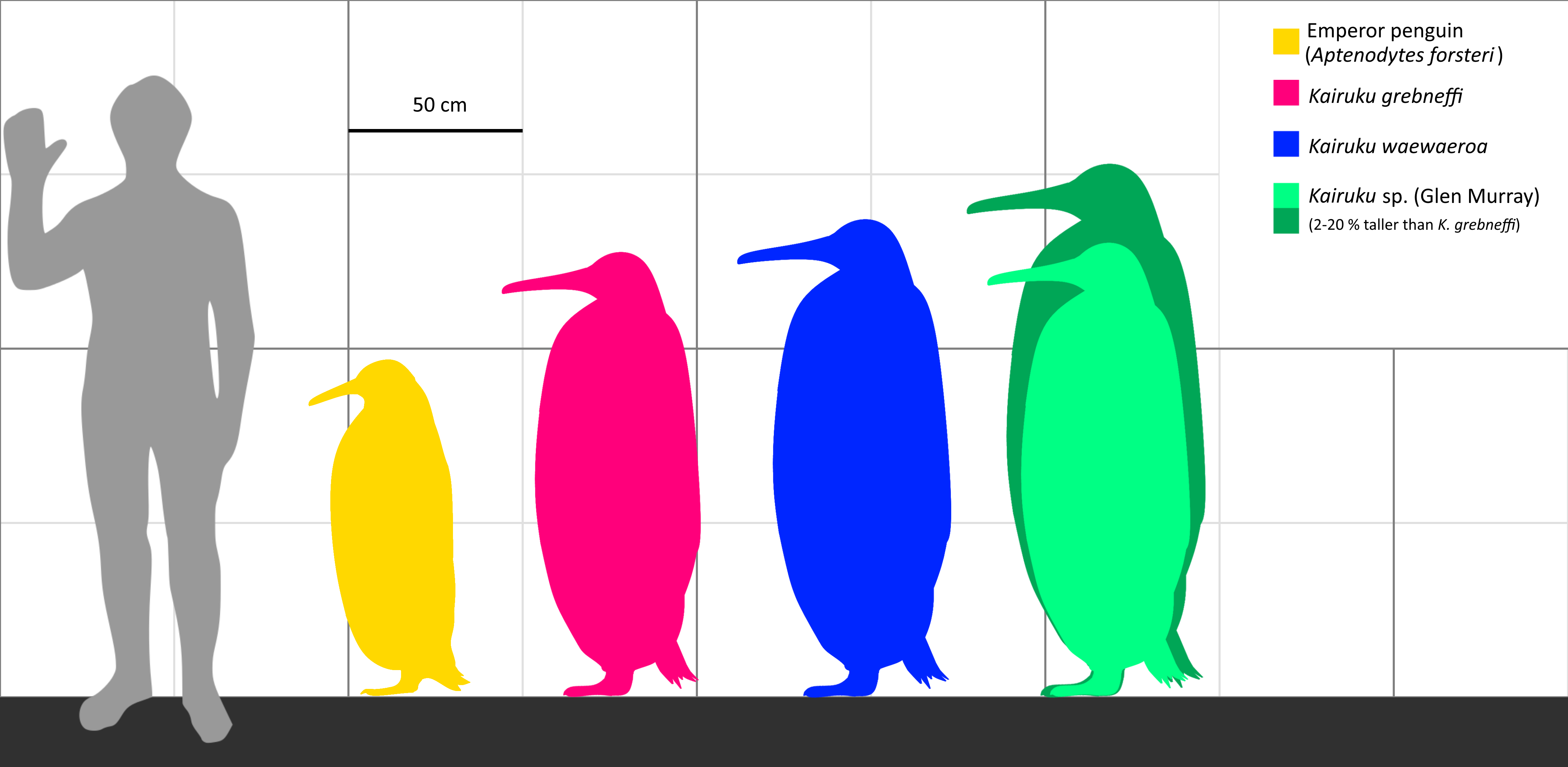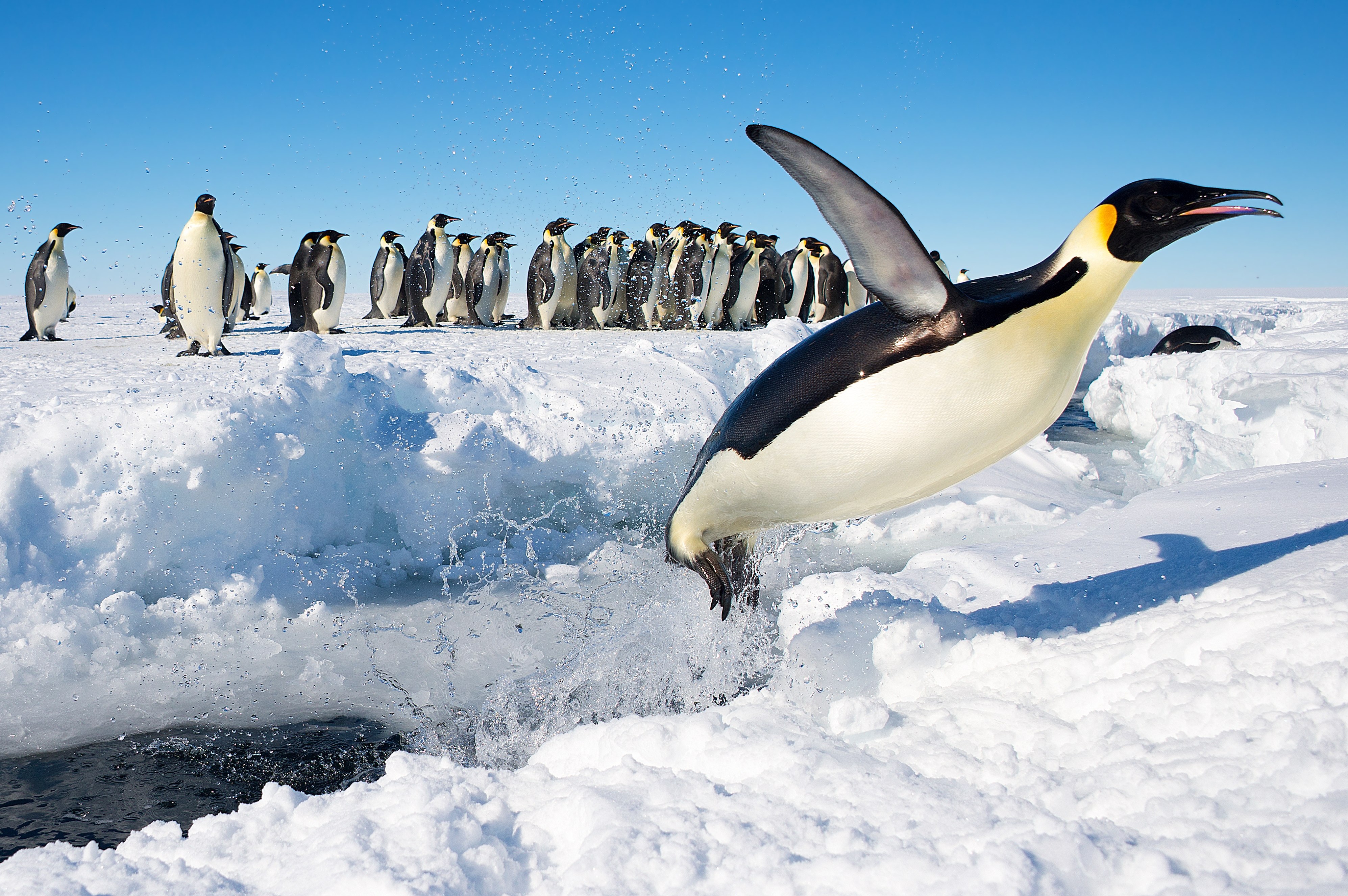|
Kairuku
''Kairuku'' is an extinct genus of penguin. It contains three species, ''K. grebneffi'', ''K. waitaki'' and ''K. waewaeroa''. This taxon is known from bones from 27 MYA (late Oligocene), from the Kokoamu Greensand Formation of New Zealand. It was historically referred to as '' Palaeeudyptes''. Etymology The name ''Kairuku'' comes from the Māori words ''kai'' (“food”) and ''ruku'' (“to dive”). From Māori waewae - "legs", roa - "long", referring to the elongated hind limbs. ''K. grebneffi'' was named after Andrew Grebneff, a paleontologist from the University of Otago who died in 2010. Distribution The fossils of ''Kairuku waewaeroa'' were found within the Glen Massey formation (34.6–27.3 Ma) in the North Island of New Zealand. Description ''Kairuku'' is one of the most completely known genus of Paleogene penguins. Described species are larger than modern emperor penguin which stood around a meter, ''K. grebneffi'' stood tall, and ''K. waewaeroa'' is ev ... [...More Info...] [...Related Items...] OR: [Wikipedia] [Google] [Baidu] |
Kairuku Scaling Species
''Kairuku'' is an extinct genus of penguin. It contains three species, ''K. grebneffi'', ''K. waitaki'' and ''K. waewaeroa''. This taxon is known from bones from 27 mya (unit), MYA (late Oligocene), from the Kokoamu Greensand Formation of New Zealand. It was historically referred to as ''Palaeeudyptes''. Etymology The name ''Kairuku'' comes from the Māori language, Māori words ''kai'' (“food”) and ''ruku'' (“to dive”). From Māori language, Māori waewae - "legs", roa - "long", referring to the elongated hind limbs. ''K. grebneffi'' was named after Andrew Grebneff, a paleontologist from the University of Otago who died in 2010. Distribution The fossils of ''Kairuku waewaeroa'' were found within the Glen Massey#Geology, Glen Massey formation (34.6–27.3 Myr, Ma) in the North Island of New Zealand. Description ''Kairuku'' is one of the most completely known genus of Paleogene penguins. Described species are larger than modern emperor penguin which stood around ... [...More Info...] [...Related Items...] OR: [Wikipedia] [Google] [Baidu] |
Kairuku Grebneffi
''Kairuku'' is an extinct genus of penguin. It contains three species, ''K. grebneffi'', ''K. waitaki'' and ''K. waewaeroa''. This taxon is known from bones from 27 MYA (late Oligocene), from the Kokoamu Greensand Formation of New Zealand. It was historically referred to as ''Palaeeudyptes''. Etymology The name ''Kairuku'' comes from the Māori words ''kai'' (“food”) and ''ruku'' (“to dive”). From Māori waewae - "legs", roa - "long", referring to the elongated hind limbs. ''K. grebneffi'' was named after Andrew Grebneff, a paleontologist from the University of Otago who died in 2010. Distribution The fossils of ''Kairuku waewaeroa'' were found within the Glen Massey formation (34.6–27.3 Ma) in the North Island of New Zealand. Description ''Kairuku'' is one of the most completely known genus of Paleogene penguins. Described species are larger than modern emperor penguin which stood around a meter, ''K. grebneffi'' stood tall, and ''K. waewaeroa'' is even l ... [...More Info...] [...Related Items...] OR: [Wikipedia] [Google] [Baidu] |
Kokoamu Greensand
The Kokoamu Greensand is a geological formation found in New Zealand. It is a fossil-bearing, late Oligocene, greensand rock unit of the eastern South Island, especially the Waitaki District of North Otago and the southern Canterbury region. The formation was named by geologist Maxwell Gage in the 1950s. In North Otago it underlies the thicker and harder Otekaike Limestone. The formation gets its green colour from the mineral glauconite which forms slowly on the ocean floor. Fossil content The formation was laid down in shallow seas some 26-30 million years ago. It contains abundant microfossils of foraminifera, ostracods and coccoliths, those of larger marine invertebrates such as the shells of brachiopods, gastropods and scallops, as well as corals, echinoderms, and crustaceans. Vertebrates found in the formation include fish, penguins and cetaceans. Many of the fossils discovered in the formation are held in the Geology Museum of the University of Otago. ;Penguins * '' ... [...More Info...] [...Related Items...] OR: [Wikipedia] [Google] [Baidu] |
Penguin
Penguins ( order Sphenisciformes , family Spheniscidae ) are a group of aquatic flightless birds. They live almost exclusively in the Southern Hemisphere: only one species, the Galápagos penguin, is found north of the Equator. Highly adapted for life in the water, penguins have countershaded dark and white plumage and flippers for swimming. Most penguins feed on krill, fish, squid and other forms of sea life which they catch with their bills and swallow it whole while swimming. A penguin has a spiny tongue and powerful jaws to grip slippery prey. They spend roughly half of their lives on land and the other half in the sea. The largest living species is the emperor penguin (''Aptenodytes forsteri''): on average, adults are about tall and weigh . The smallest penguin species is the little blue penguin (''Eudyptula minor''), also known as the fairy penguin, which stands around tall and weighs . Today, larger penguins generally inhabit colder regions, and smaller penguins in ... [...More Info...] [...Related Items...] OR: [Wikipedia] [Google] [Baidu] |
Palaeeudyptes
''Palaeeudyptes'' is an extinct genus of large penguins, currently containing four accepted species. They were probably larger than almost all living penguins, with the smaller species being about the size of an emperor penguin, and the largest species, ''Palaeeudyptes klekowskii'', having stood up to tall and weighed up to . Known species Of the four species, two (''P. gunnari'' and ''P. klekowskii'') are known from numerous remains found in Middle or Late Eocene strata (34 to 50 MYA) of the La Meseta Formation on Seymour Island, Antarctica. ''P. antarcticus'', the first fossil penguin described, is only really known from a single incomplete tarsometatarsus found in the Late Oligocene Otekaike Limestone (23 to 28, possibly up to 34 MYA) at Kakanui, New Zealand, but numerous other bones have been tentatively assigned to the species. The other described New Zealand species, ''P. marplesi'', is known from parts of a skeleton, mainly leg bones, from the Middle or Late Eocene B ... [...More Info...] [...Related Items...] OR: [Wikipedia] [Google] [Baidu] |
Extant Taxon
Neontology is a part of biology that, in contrast to paleontology, deals with living (or, more generally, ''recent'') organisms. It is the study of extant taxa (singular: extant taxon): taxa (such as species, genera and families) with members still alive, as opposed to (all) being extinct. For example: * The moose (''Alces alces'') is an extant species, and the dodo (''Raphus cucullatus'') is an extinct species. * In the group of molluscs known as the cephalopods, there were approximately 600 extant species and 7,500 extinct species. A taxon can be classified as extinct if it is broadly agreed or certified that no members of the group are still alive. Conversely, an extinct taxon can be reclassified as extant if there are new discoveries of living species (" Lazarus species"), or if previously-known extant species are reclassified as members of the taxon. Most biologists, zoologists, and botanists are in practice neontologists, and the term neontologist is used ... [...More Info...] [...Related Items...] OR: [Wikipedia] [Google] [Baidu] |
Discovery Channel
Discovery Channel (known as The Discovery Channel from 1985 to 1995, and often referred to as simply Discovery) is an American cable channel owned by Warner Bros. Discovery, a publicly traded company run by CEO David Zaslav. , Discovery Channel was the third most widely distributed subscription channel in the United States, behind now-sibling channel TBS and The Weather Channel; it is available in 409 million households worldwide, through its U.S. flagship channel and its various owned or licensed television channels internationally. It initially provided documentary television programming focused primarily on popular science, technology, and history, but by the 2010s had expanded into reality television and pseudo-scientific entertainment. , Discovery Channel is available to approximately 88,589,000 pay television households in the United States. History John Hendricks founded the channel and its parent company, Cable Educational Network Inc., in 1982. Several inv ... [...More Info...] [...Related Items...] OR: [Wikipedia] [Google] [Baidu] |
Bangkok Post
The ''Bangkok Post'' is an English-language daily newspaper published in Bangkok, Thailand. It is published in broadsheet and digital formats. The first issue was sold on 1 August 1946. It had four pages and cost one baht, a considerable amount at the time when a baht was a paper note. It is Thailand's second oldest newspaper and the oldest still in publication. The daily circulation of the ''Bangkok Post'' is 110,000, 80 percent of which is distributed in Bangkok and the remainder nationwide. From July 2016 until mid-May 2018, the editor of the ''Bangkok Post'' was Umesh Pandey. On 14 May 2018, Umesh was "forced to step down" as editor after refusing to soften coverage critical of the ruling military junta. History The ''Bangkok Post'' was founded by Alexander MacDonald, a former OSS officer, and his Thai associate, Prasit Lulitanond. Thailand at the time was the only Southeast Asian country to have a Soviet Embassy. The U.S. embassy felt it needed an independent, but gener ... [...More Info...] [...Related Items...] OR: [Wikipedia] [Google] [Baidu] |
Agence France-Presse
Agence France-Presse (AFP) is a French international news agency headquartered in Paris, France. Founded in 1835 as Havas, it is the world's oldest news agency. AFP has regional headquarters in Nicosia, Montevideo, Hong Kong and Washington, D.C., and news bureaus in 151 countries in 201 locations. AFP transmits stories, videos, photos and graphics in French, English, Arabic, Portuguese, Spanish, and German. History Agence France-Presse has its origins in the Agence Havas, founded in 1835 in Paris by Charles-Louis Havas, making it the world's oldest news service. The agency pioneered the collection and dissemination of news as a commodity, and had established itself as a fully global concern by the late 19th century. Two Havas employees, Paul Julius Reuter and Bernhard Wolff, set up their own news agencies in London and Berlin respectively. In 1940, when German forces occupied France during World War II, the news agency was taken over by the authorities and renam ... [...More Info...] [...Related Items...] OR: [Wikipedia] [Google] [Baidu] |
Vertebrae
The spinal column, a defining synapomorphy shared by nearly all vertebrates, Hagfish are believed to have secondarily lost their spinal column is a moderately flexible series of vertebrae (singular vertebra), each constituting a characteristic irregular bone whose complex structure is composed primarily of bone, and secondarily of hyaline cartilage. They show variation in the proportion contributed by these two tissue types; such variations correlate on one hand with the cerebral/caudal rank (i.e., location within the backbone), and on the other with phylogenetic differences among the vertebrate taxa. The basic configuration of a vertebra varies, but the bone is its ''body'', with the central part of the body constituting the ''centrum''. The upper (closer to) and lower (further from), respectively, the cranium and its central nervous system surfaces of the vertebra body support attachment to the intervertebral discs. The posterior part of a vertebra forms a vertebral ... [...More Info...] [...Related Items...] OR: [Wikipedia] [Google] [Baidu] |
Sister Species
In phylogenetics, a sister group or sister taxon, also called an adelphotaxon, comprises the closest relative(s) of another given unit in an evolutionary tree. Definition The expression is most easily illustrated by a cladogram: Taxon A and taxon B are sister groups to each other. Taxa A and B, together with any other extant or extinct descendants of their most recent common ancestor (MRCA), form a monophyletic group, the clade AB. Clade AB and taxon C are also sister groups. Taxa A, B, and C, together with all other descendants of their MRCA form the clade ABC. The whole clade ABC is itself a subtree of a larger tree which offers yet more sister group relationships, both among the leaves and among larger, more deeply rooted clades. The tree structure shown connects through its root to the rest of the universal tree of life. In cladistic standards, taxa A, B, and C may represent specimens, species, genera, or any other taxonomic units. If A and B are at the same taxono ... [...More Info...] [...Related Items...] OR: [Wikipedia] [Google] [Baidu] |


.png)